How Peter D’Epiro trains Spec Ops, Apple, Google execs and so much more…
By Adrienne Harvey, SrPCC, RKC-II, CK-FMS
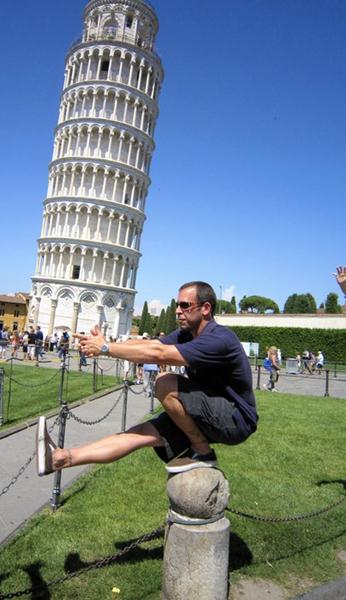
Dragon Door: You've been in fitness and performance coaching for 20 years, how did you get started in that career?
Peter D’Epiro: In some ways it was a straight shot. My bachelor's degree is in exercise science, and my master’s degree is in human movement. I started personal training almost from graduation. It was inline with what I studied, and my lifestyle as a gymrat and former athlete.
Dragon Door: How long have you been a gymrat?
Peter D’Epiro: I started in high school. My mom wouldn't let me lift weights until after my freshman year, but as soon as I could, I ran to my basketball coach and asked him what to do! At that time I was weightlifting for sports, but what we thought was performance training in the 80s and 90s was actually bodybuilding. I would either try to sneak out of the house to go to the gym late at night, or I would get up really early in the morning to go to the gym before school. Soon, the gym started trumping my passion for sports. I didn’t play competitive sports in college so the gym became my outlet for what sports psychology calls "termination trauma". Since I wasn’t formally playing sports I needed an outlet for exercise and competitiveness.
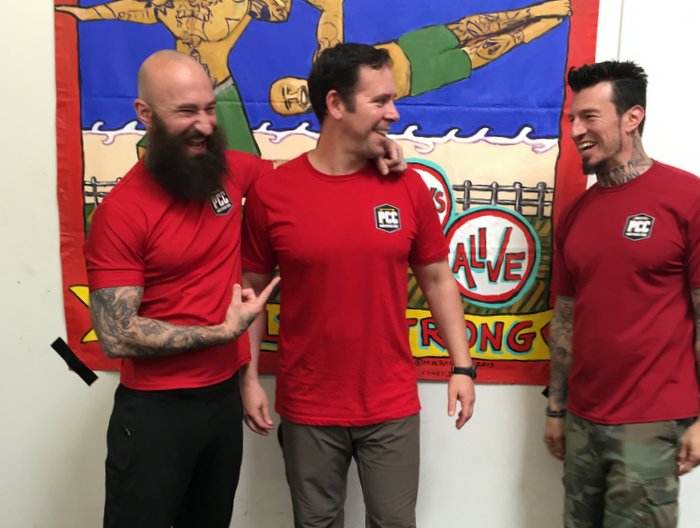
It's also how I chose my degrees. I went in undeclared, and found myself filling my general education requirements with classes like human anatomy lab and lecture, and nutrition. Unbeknownst to me these classes also lead towards a degree in exercise science.
Dragon Door: And now you train everyone from Silicon Valley executives to elite athletes, and military special operations candidates. How you start training these interesting populations?
Peter D’Epiro: I live in Silicon Valley. Our facility is near the Google offices and the Apple offices are just a few miles away, so that’s the demographic here. While one of my niches is performance training for athletes, It's tough to build a whole business around it. It would mean only working after school, on weekends or during the summer. Because I’m also a parent, when my son is out of school I want to be with him.
So, training the local executives and entrepreneurs is the bread and butter of our training business. We also pursue a niche demographic with junior athletes—middle school through college. It can be challenging to begin in performance training, but I had built a personal network while growing up in the area. I have been able to train whole teams and used to rent my high school weight room and football field every summer to run large performance camps.
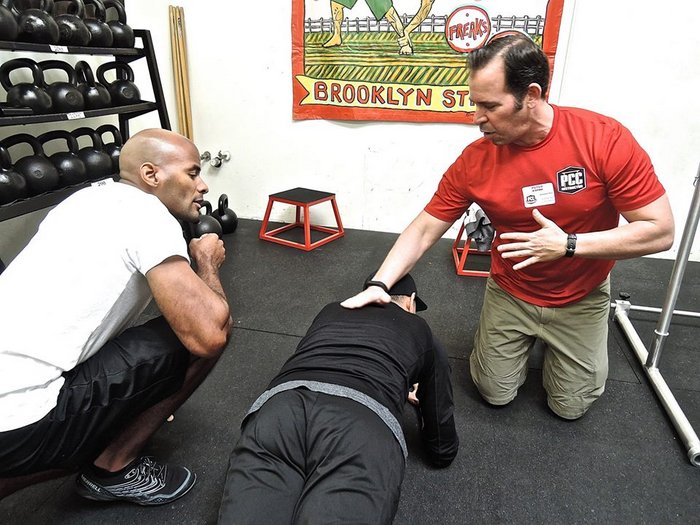
Some of my training success is due to a "war of attrition". Since I have been a
personal trainer for years, I get a lot of word of mouth referrals, or people find me in the same place when they are ready to commit. I’ve even had clients move away for a job, return 5-10 years later and train with me again.
How I started training military candidates was a unique path as I didn't serve, and I don't serve. Many people are familiar with the movie
Lone Survivor. One of the main characters, Axe, was one of my childhood classmates and friends. The story of what happened profoundly affected everyone in our community, especially those of us who grew up with him. My dad served in WWII and his generation didn't talk about the military. I think my dad even tried to shield me from it.
Matt Axelson—nicknamed Axe in the movie—grew up here in Cupertino. He and another one of my friends served in the SEAL Teams, and it wasn’t something that they chatted about—it wasn’t really even part of their persona. Matt was a quiet, laidback guy, so I didn’t really know what they did. After Matt died, I read
Lone Survivor, watched documentaries, learned about BUDS, and realized what these guys had done for a living—all while going about their business without much fanfare.
I also learned about Heroes of Tomorrow, a nonprofit run by former SEAL officer Stew Smith. Heroes of Tomorrow provides free training from local volunteers to guys going to military special operations selection schools. It’s usually Navy guys who want to go to BUDS and have found the organization because they’ve found Stew Smith. Stew is known for strength and conditioning in the military.
Dan John has been helpful because he works with active duty special operations guys, so I have been able to ask him questions about training this unique demographic. There’s an important distinction between active duty and someone trying out. The guys I train will need to pass the fitness test week in and week out before the Navy will send them off to boot camp and then to BUDS. So, they need to do timed sit ups,
push ups, max pull ups, a mile and a half run, and a swim—and score above a certain level. So, we need to prepare and injury-proof them because they will be overtraining to some degree.
Testing is not always optimal for performance or health. We need to buffer them against potential problems while also preparing them to pass the tests week in and week out.
Dragon Door: What are the biggest challenges in this type of training?
Peter D’Epiro: It varies. I used to copy Stew’s model. He works out every morning and people join him. Then, I realized that many of these guys had quit their jobs and were training full time—often several times per day—until they were shipped off to boot camp. Working out with me for an hour every morning wasn’t necessarily going to have a huge impact. I realized that it was more valuable for them to meet with me individually to work on their overall program. We find the gaps in their training, which might be recovery or overtraining issues, or issues related to a specific test.
One of the guys I am training right now is dialed-in and diligent. He’s a really muscular, athletic guy but needs to work on his posture and some mobility issues. So that he can swim as much as he will need to—while staying healthy—we’re working on his shoulder and thoracic spine mobility. These guys are like sponges and many of them train full time. Instead of one challenge it’s more about identifying and filling the holes in their overall program. Sometimes the issues are very global, but sometimes they’re really technical.
Another example is a young man I worked with who was stuck at 15 pull ups (which is fantastic by my standards) but they need to get towards 20 pull ups. In one of our meetings I introduced him to ladders, we worked on the hollow body position, and
pull up technique. I also gave him a few different workout structures like
Dan John’s 5x5 for working on the strength end of the spectrum, versus just high volume unloaded training. Within a couple of weeks he texted that he did 22 pull ups on his test. He had just needed to refine his technique. Sometimes the issues are more general—how many times per week they are training—or we may need to overhaul their whole program.
Dragon Door: It must be inspiring to work with people who are that motivated and driven!
Peter D’Epiro: It’s unique. They’re motivated and driven but also have a sort of humility and grace about them. It’s really profound because they are often young kids just out of college or they didn’t go to college. They should be these 20-something punks, but instead they are super nice, super respectful, gracious, and all-ears when I’m helping them. They’re the best clients you could imagine, it's amazing.
Dragon Door: I remember you were at the first ever PCC workshop we had in St. Paul, Minnesota in 2013. What inspired you to go to that first workshop?
Peter D’Epiro: It's tough to remember, but the fundamental thing was I had been reading the
Convict Conditioning books, so it was a natural fit!
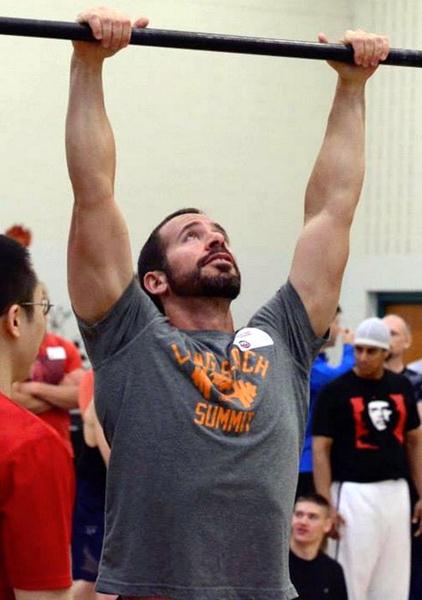
Dragon Door: How are you using your PCC knowledge with your various clients?
Peter D’Epiro: I like to use calisthenics exercises like pull ups then borrow programming from
kettlebell training—ladders, the 5x5, adding load, or simply progressing towards a one arm pull up. Having both buckets of tools to pull from provides a lot of opportunity for progression and regression. I think the biggest thing from the PCC is how calisthenics can be very pure
strength movements, skills, and challenges.
When I am working with younger athletes, it’s better if we can use a bodyweight exercise that's as challenging as a heavy-loaded strength exercise. It’s safer than using heavy external loads because they may not be skilled enough to manage the weight. Also, even though they are athletes, they may not yet be able to understand concepts like total body tension. They are often still developing an awareness of their bodies. I like the self-limiting concept with
calisthenics exercises—the only way to do the exercises is to start developing full body tension. So, young athletes can naturally start learning total body tension before they’re actually cognizant of it—this unconscious learning seems to transfer well to their sports performance.
Dragon Door: What are you working on in your own training?
Peter D’Epiro: I don’t have a particular focus outside of being healthy. Almost all of my training is calisthenics and
kettlebells—and I go back and forth with running, cycling, and recreational activities. Occasionally I will train for a race or a certification. I am focused on my work and being a parent, just like many of my clients. But, I may take on a challenge when my schedule can accommodate it. It’s good for young trainers to know that being in the fitness industry isn’t just about us—even though I should model what I am teaching and live the lifestyle, my energy should be focused on my clients, my family, and how I can help them.
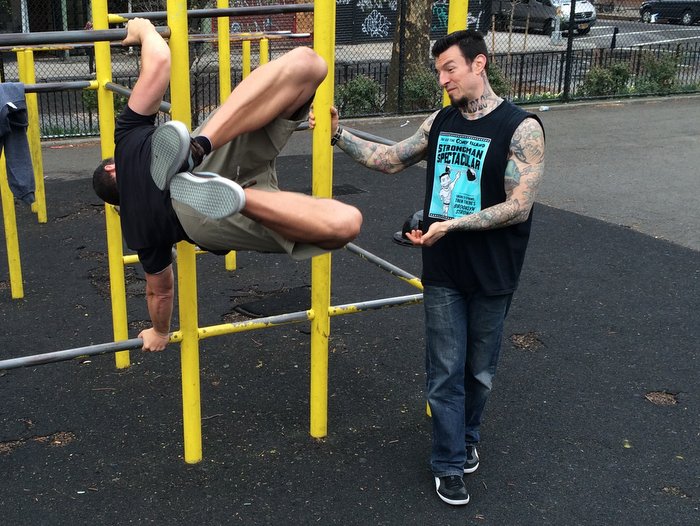
Dragon Door: What’s one of the biggest things you’ve learned from twenty years of personal training?
Peter D’Epiro: One crucial piece of my career—and something I try to teach clients—is balance in life. Around Silicon Valley it’s called work-life balance, but it applies to our work in fitness as well. I’ve been an independent trainer for nearly all of my career, so first, I’ve had to earn enough money to live and help support a family in one of the most expensive areas in the country—while keeping a work-life balance. I want to pick my son up from school, coach his sports teams, and be with him on weekends. Success isn’t just how many hours I’m training or how much money I’m making, it’s about work accommodating and facilitating my lifestyle. Wellness from a balanced life is more important that just fitness and strength numbers, and in this field I believe you have to work towards that goal.
Dragon Door: How do you maintain your work-life balance?
Peter D’Epiro: Some of it is business sense. One thing I had to address early in my career was to stop charging people per session and letting them cancel. Instead, I started charging a monthly flat fee, so I don’t have to count my sessions week to week. It puts me on a payroll of sorts, and my clients know how much they will be paying every month. Then I have a certain rigidity about scheduling, and stick to my guns about when I will be finished for the day and when I will be available.
In the past I’ve ended up working every Saturday morning for periods of time, but now I make an overt effort to not work on the weekends or times that would conflict with spending time with my son. Of course in the beginning this is hard when you’re trying to
build a business, but since I have now been in the same place for the past twenty years, it works. While I may lose a client here or there, in the end life is better overall.
Dragon Door: That is a powerful example from a trainer of over twenty years. And you’ve managed to attend a PCC then help teach at two more!
Peter D’Epiro: Going to the PCC is like a vacation for me because it is so fun, refreshing and inspiring. In my training I am also trying to improve some of my calisthenics skills. Recently, some of my coworkers (who are also PCC instructors) and I were spotting each other on the
flag progressions. While I am a good communicator and teacher, one of my big goals is to improve my higher end calisthenics so I can demonstrate them too.
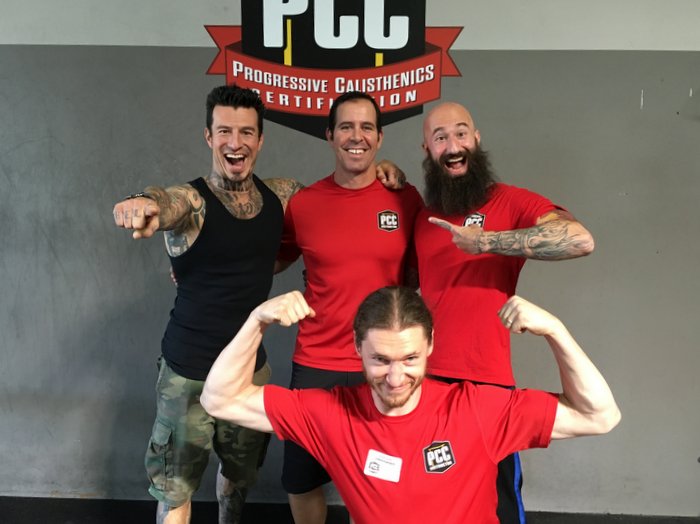
It's really humbling. The first PCC was a weekend of 1RMs for me on everything. While I could already do pull ups and
pistol squats, I wasn't proficient with many of the other skills. The clutch flag was a first along with an assisted low bar jumping muscle up. Everything was challenging!
I’ve definitely learned something new at each PCC. There are progressions that aren’t even in the book. The simplicity of the PCC is phenomenal, it is probably one of the most uniquely incredible experiences in the industry for a variety of reasons.
Back